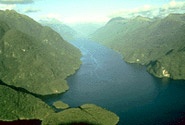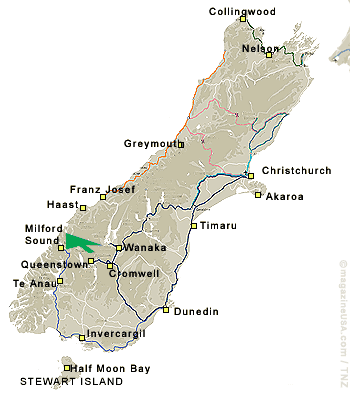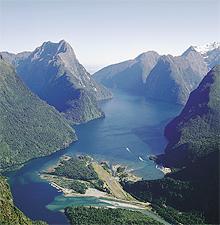
Te Wahipounamu-South West New Zealand- |
www.shejapan.com > World Heritages > Te Wahipounamu
Quiz:
|
|
|
|
<経済学部3年 佐藤 祐哉>

Inscribed :1990 Criteria: (ⅱ)(ⅷ)(ⅹⅰ)(ⅹ)
Brief description:
The landscape in this park, situated in south-west New Zealand, has been shaped by successive glaciations into fjords, rocky coasts, towering cliffs, lakes and waterfalls. Two-thirds of the park is covered with southern beech and pod carps, some of which are over 800 years old. The kea, the only alpine parrot in the world, lives in the park, as does the rare and endanger takahe, a large flightless bird.

When the Maori arrived, they found a land rich in resources they could use to sustain their existence and around which they could build their culture. (1)Abundant birds and fish provided food, the bush gave them timber. But the most valuable prize was hewn from the rock of Aoraki's mythical canoe and was reflected in the name the Maori gave the region: Te Wahipounamu, or the place of the greenstone. (2)Greenstone (nephrite) was the most precious of all stone to the Maori. It was used for tools, weapons and ornaments, and in some forms is believed to have spiritual force. It was certainly the most important item the Ngai Tahu had to trade with other tribes, and the stone from Te Wahipounamu was spread throughout New Zealand

ALONE IN THE WILDERNESS
Today experienced trampers can find ①huge expanses which offer neither tracks nor huts nor any other sign
of human inhabitation, giving them the opportunity to revel in the rare and sometimes frightening sense of ( ② )
solitude.(3) With no roads, houses, traffic or noise, walkers easily find themselves overwhelmed by their
insignificance in the midst of the magnificent mountain and forest scenery that surrounds them. They are left to
depend on their own resources in the knowledge that they are hours away from outside help.
But less hardy - or more gregarious - visitors can enjoy Te Wahipounamu's wonders in a little more comfort.
The world-famous Milford Track offers guided or independent walks of two to five days through spectacular scenery,
as do several other ③less well-known trails, such as the Route burn, Greenstone or Holyford tracks. Numerous shorter
walks, ranging from thirty minutes to a full day, are spread along the length of Te Wahipounamu, giving safe and easy
access to the wilderness. Several of these walks have been equipped with informative displays to help explorers understand
the surrounding landforms, wildlife or vegetation.
But (4)such displays cannot tell all there is to know about Te Wahipounamu. The region's 2.6 million hectares are
breathtaking in the extent and variety of their natural beauty. Forming fully a tenth of New Zealand's entire landmass,
the area is united only by its diversity. Changes in vegetation and scenery ( ④ ) span thousands of kilometers on
the continents are compressed into an area only about 450 km long and between 40 to 90 km wide.
The area contains New Zealand's highest mountains, longest glaciers, tallest forests, wildest rivers and gorges,
most rugged coastline, deepest fjords and lakes, and largest populations of forest birds. It is home to the world's
largest buttercup, the Mt. Cook Buttercup; possibly the highest sea cliff, Mitre Peak; the world's only alpine parrot,
the friendly but mischievous kea; and the total wild population of the rare takahe.
There are dozens of bird species in Te Wahipounamu, ( ⑤ ) many found only in New Zealand.
(5)Among the best known is the kea, which shows no fear of intruders, and in fact often seems to actively seek contact
with humans - often to their discomfort. With its strong hooked beak, this inquisitive bird can destroy sneakers left
outside overnight, canvas or vinyl bags and anything else it decides to take an interest ( ⑥ ).
New Zealand's smallest bird, the rifleman, lives in the region's mountain forests, and the tiny rock wren can be spotted
in alpine areas. One of New Zealand's few alpine birds, the rock wren survives the harsh mountain winters by sheltering in
openings within the rock debris beneath the snow. Further down the mountains, the beautifully echoing song of the aptly
named bellbird, or korimako, is commonly heard, and careful observers can also see the tui, bush robin, flocks of screeching
kaka (forest parrot) and kakariki (parakeet). Tawaki or Fjord land crested penguins inhabit parts of the coastline, while
about 50 pairs of the beautiful kotuku (white heron) regularly nest at the northern end of the region.( ⑦ ) common
in other countries, the kotuku is rare in New Zealand and has great spiritual significance for the Maori, who see it
as a symbol of all that is beautiful and rare.
Notes
resource
源
abundant
豊富な
timber
木材
ornament
装飾
magnificent
壮大な
gregarious
群生する
spectacular
壮観な
glacier
氷河
What's Maori??
Welcome to Newzeland
Te Wahipounamuの鳥
www.shejapan.com
> World
Heritages > Te Wahipounamu
© 2008 SHEJapan.com